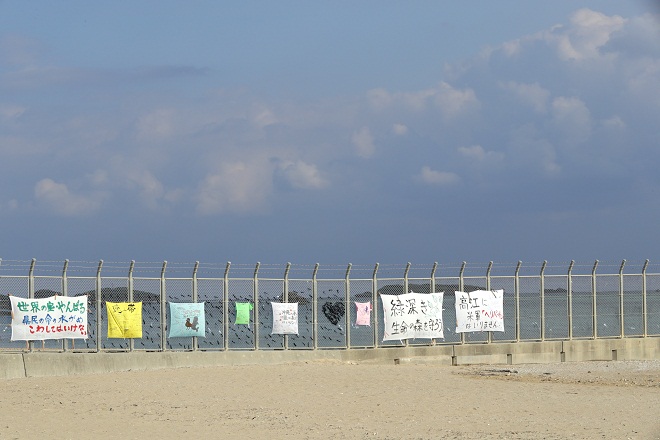Over years, Henoko undergoes changes due to US base plan
February 3, 2018
Nago, Okinawa Pref.- Henoko, a small coastal settlement with a population of about 2,000 in Nago, Okinawa Prefecture, has undergone changes over the two decades since it emerged as a candidate relocation site for a controversial U.S. military base.
"Henoko has changed," Ken Kohagura, a 50-year-old resident, said at a local port, looking at Henokozaki cape in the US military's Camp Schwab.
Kohagura stared at cranes and other heavy machinery engaged in the construction of a replacement facility for the US Marine Corps' Futenma air station on reclaimed land jutting into the emerald green sea. Embankment construction work began in April last year.
Located on the east coast of Okinawa's main island, southern Japan, Henoko is separated by Yanbaru forest from the western coast area, where city hall and many shops are located. The Henoko district has lagged economically, although it was dotted with eating places for U.S. servicemen during the Vietnam War.
Around 1997, Henoko was chosen as a candidate site for the Futenma replacement facility. Since then, those in favor of the transfer have locked horns with opponents in a confrontation filled with hatred.
The relocation of the Futenma base from a congested area of Ginowan, another Okinawa city, to Henoko is regarded as the main campaign issue in the Nago mayoral election slated for Sunday.
The Japanese government, which promotes the relocation under an agreement with the United States, has taken a number of steps to win opponents over, such as by offering budgetary appropriations to Henoko under a variety of projects, which financed the construction of a "kosen" technical college and other public buildings in and around the district.
After the Nago city government refused to receive state subsidies designed to facilitate the realignment of US forces stationed in Japan, the central government started to provide financial aid directly to Henoko in 2015.
"Only about 10 households still oppose the relocation plan," one Henoko resident said.
After the embankment work started, the central government hired local fishermen to monitor opposition activists who approach the construction site in canoes and boats.
A daily allowance of some 50,000 yen, including gasoline costs, is paid to each fishing boat skipper who offers the vessel to keep an eye on anti-US base activists. To make a living, many Henoko fishermen take turns to join the lookout.
Shogo Kawakami, 36, is one such local fisherman. In 1997, when Kawakami was a high school student, a male relative attempted suicide after being torn between supporters of the Futenma relocation and opponents.
"Henoko has been thrown about by (the relocation issue) for over 20 years," Kawakami said. "I don't want my children to have the same problem."
"It's about time we move forward" with the base relocation, Kawakami said determinedly.
Near the local port, a signboard marking a continuing sit-down of 5,034 days as of Monday stood in front of a tent of activists opposing the relocation.
"We don't need a military base!" yelled dozens of people holding placards at trucks coming from a Camp Schwab gate.
Some local opponents have passed away over the past two decades, with civic group "Inochi wo Mamoru Kai," which once played the main role in countering the base relocation project, now dissolved.
"We can't give up," Fumiko Shimabukuro, an 88-year-old opponent, said. "I can't die without stopping the base relocation." Jiji Press
Latest Videos
- THE UNTOLD STORY EXPERT INSIGHTS INTO THE UKRAINE
- NEGOTIATING A NEW ORDER US RUSSIA TALKS ON UKRAIN
- Ukraine: A Pawn in the Geopolitical Game? Will Trump Intervene?
- US VP VANCE CRITICIZES EUROPEAN DEMOCRACIES AT MUNICH SECURITY CONFERENCE
- UNCOVERING THE WEB OF DECEIT: CIA INFILTRATION OF THE MEDIA
- SHIFTING SANDS: TULSI GABBARD’S CONFIRMATION AND THE EVOLVING GLOBAL LANDSCAPE
- FAUCI SCANDAL: A THREAT TO GLOBAL HEALTH AND DEMOCRACY






